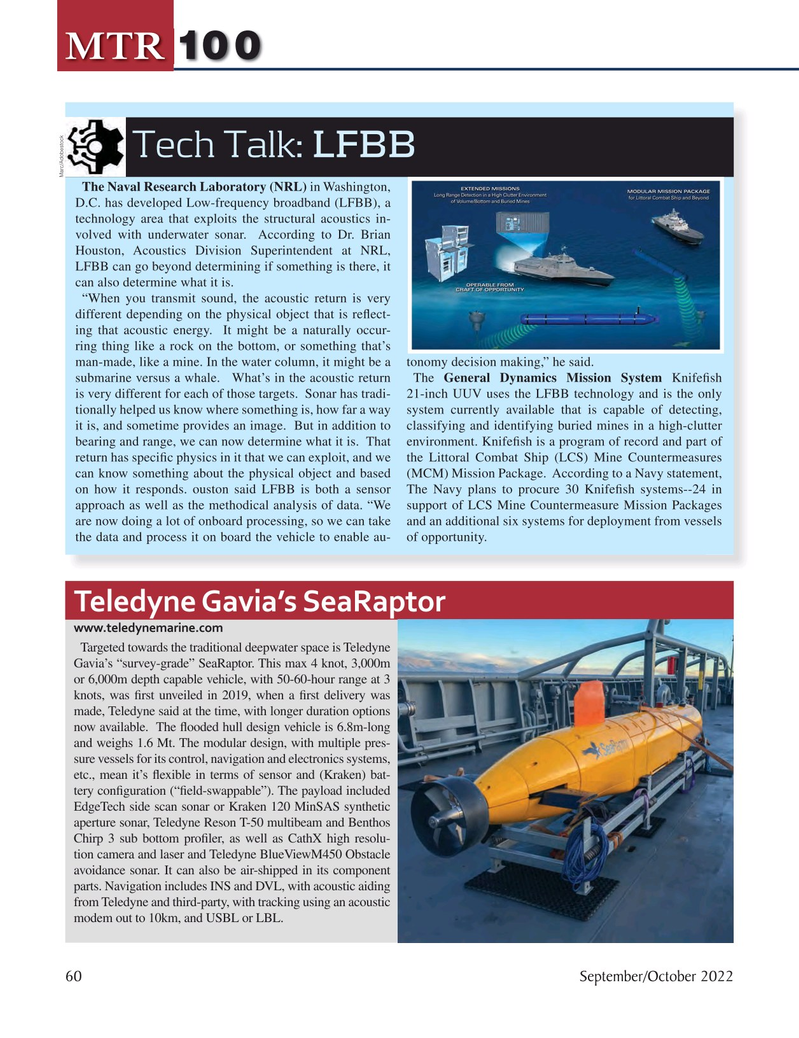
Page 60: of Marine Technology Magazine (September 2022)
Read this page in Pdf, Flash or Html5 edition of September 2022 Marine Technology Magazine
MTR 100
Tech Talk: LFBB
Marc/Adobestock
The Naval Research Laboratory (NRL) in Washington,
D.C. has developed Low-frequency broadband (LFBB), a technology area that exploits the structural acoustics in- volved with underwater sonar. According to Dr. Brian
Houston, Acoustics Division Superintendent at NRL,
LFBB can go beyond determining if something is there, it can also determine what it is.
“When you transmit sound, the acoustic return is very different depending on the physical object that is re? ect- ing that acoustic energy. It might be a naturally occur- ring thing like a rock on the bottom, or something that’s man-made, like a mine. In the water column, it might be a tonomy decision making,” he said.
submarine versus a whale. What’s in the acoustic return The General Dynamics Mission System Knife? sh is very different for each of those targets. Sonar has tradi- 21-inch UUV uses the LFBB technology and is the only tionally helped us know where something is, how far a way system currently available that is capable of detecting, it is, and sometime provides an image. But in addition to classifying and identifying buried mines in a high-clutter bearing and range, we can now determine what it is. That environment. Knife? sh is a program of record and part of return has speci? c physics in it that we can exploit, and we the Littoral Combat Ship (LCS) Mine Countermeasures can know something about the physical object and based (MCM) Mission Package. According to a Navy statement, on how it responds. ouston said LFBB is both a sensor The Navy plans to procure 30 Knife? sh systems--24 in approach as well as the methodical analysis of data. “We support of LCS Mine Countermeasure Mission Packages are now doing a lot of onboard processing, so we can take and an additional six systems for deployment from vessels the data and process it on board the vehicle to enable au- of opportunity.
Teledyne Gavia’s SeaRaptor www.teledynemarine.com
Targeted towards the traditional deepwater space is Teledyne
Gavia’s “survey-grade” SeaRaptor. This max 4 knot, 3,000m or 6,000m depth capable vehicle, with 50-60-hour range at 3 knots, was ? rst unveiled in 2019, when a ? rst delivery was made, Teledyne said at the time, with longer duration options now available. The ? ooded hull design vehicle is 6.8m-long and weighs 1.6 Mt. The modular design, with multiple pres- sure vessels for its control, navigation and electronics systems, etc., mean it’s ? exible in terms of sensor and (Kraken) bat- tery con? guration (“? eld-swappable”). The payload included
EdgeTech side scan sonar or Kraken 120 MinSAS synthetic aperture sonar, Teledyne Reson T-50 multibeam and Benthos
Chirp 3 sub bottom pro? ler, as well as CathX high resolu- tion camera and laser and Teledyne BlueViewM450 Obstacle avoidance sonar. It can also be air-shipped in its component parts. Navigation includes INS and DVL, with acoustic aiding from Teledyne and third-party, with tracking using an acoustic modem out to 10km, and USBL or LBL.
60 September/October 2022
MTR #7 (50-65).indd 60 10/3/2022 9:16:53 AM

 59
59

 61
61
